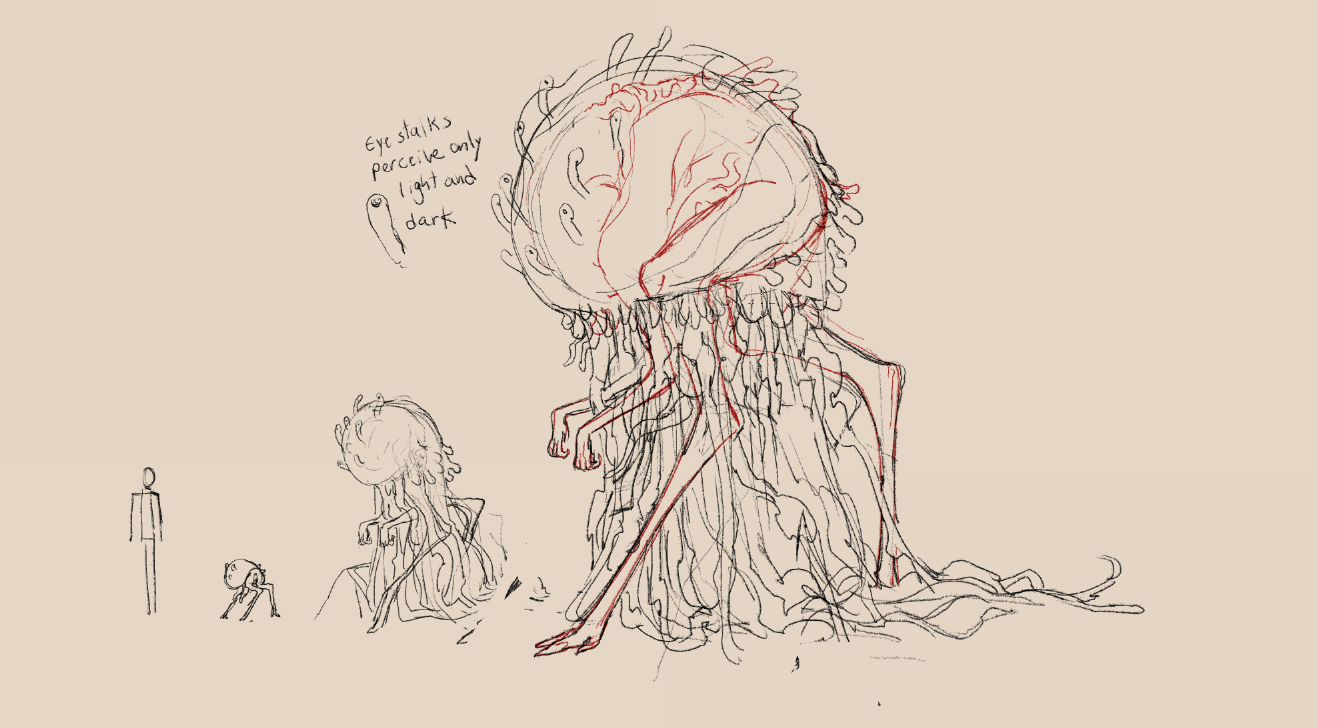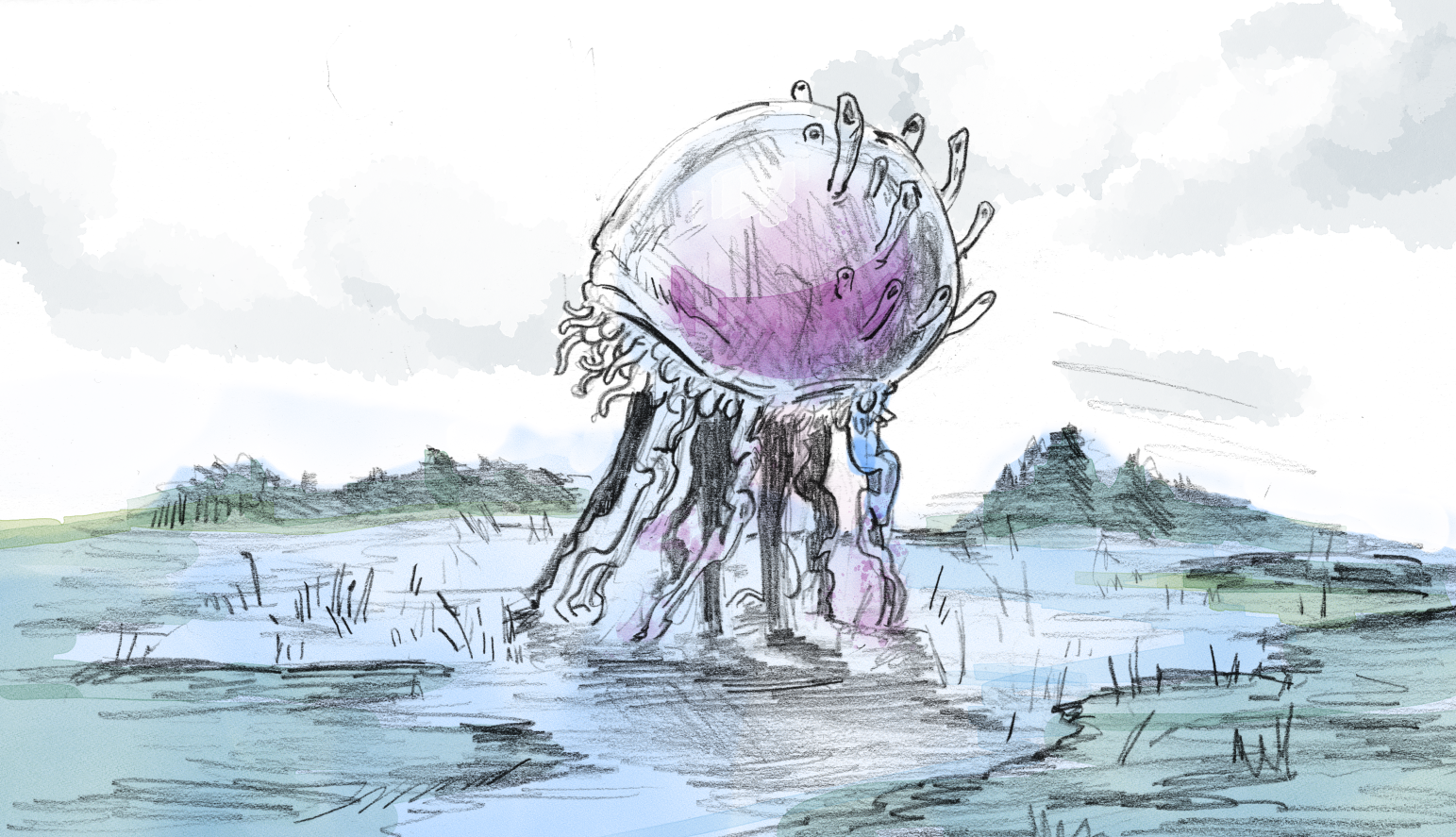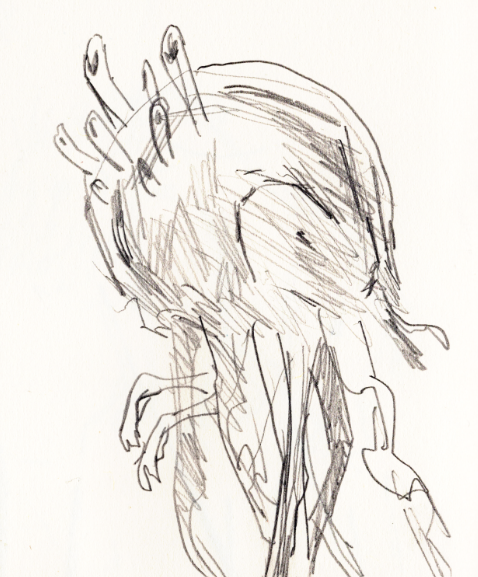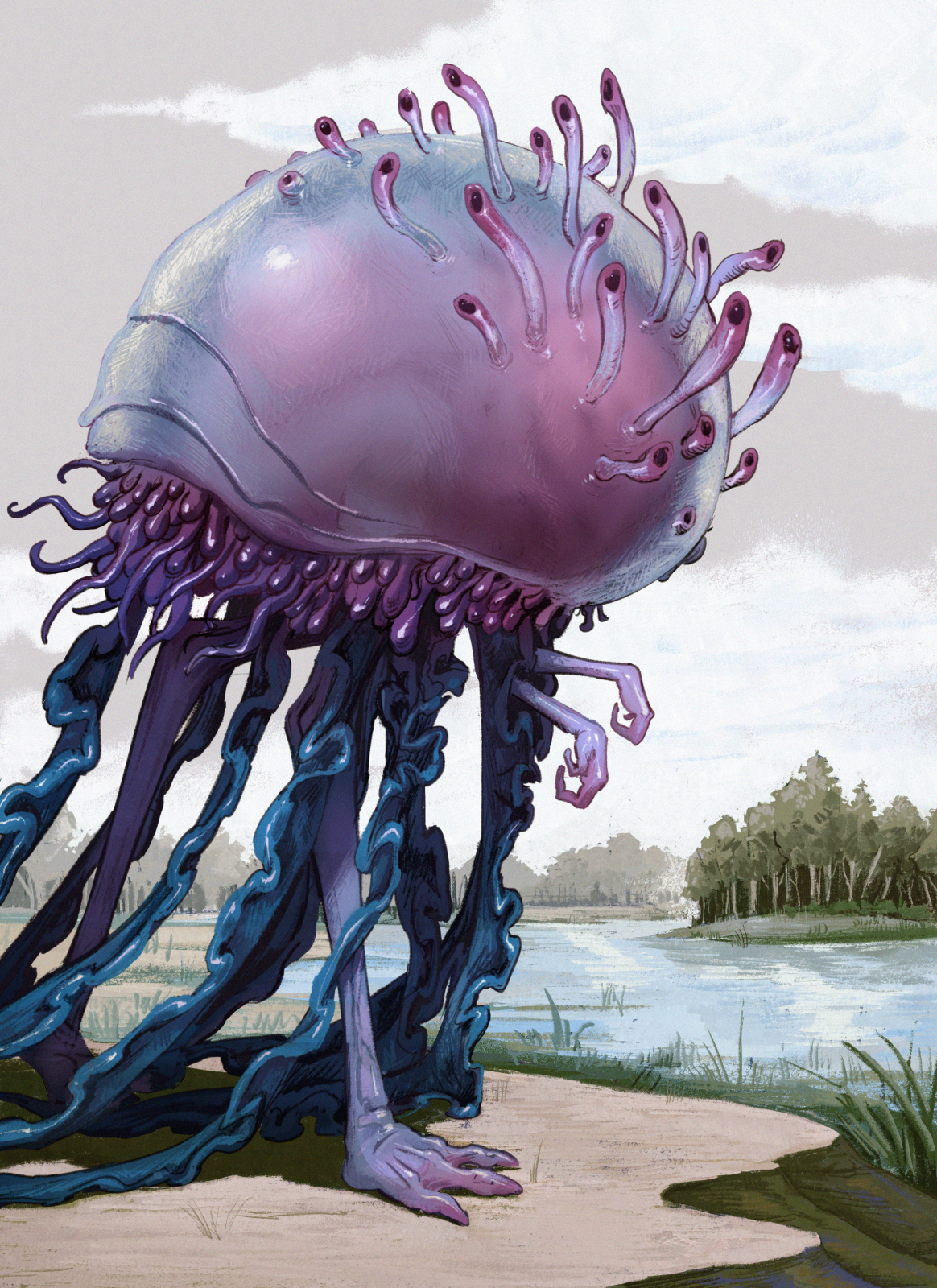
Page One
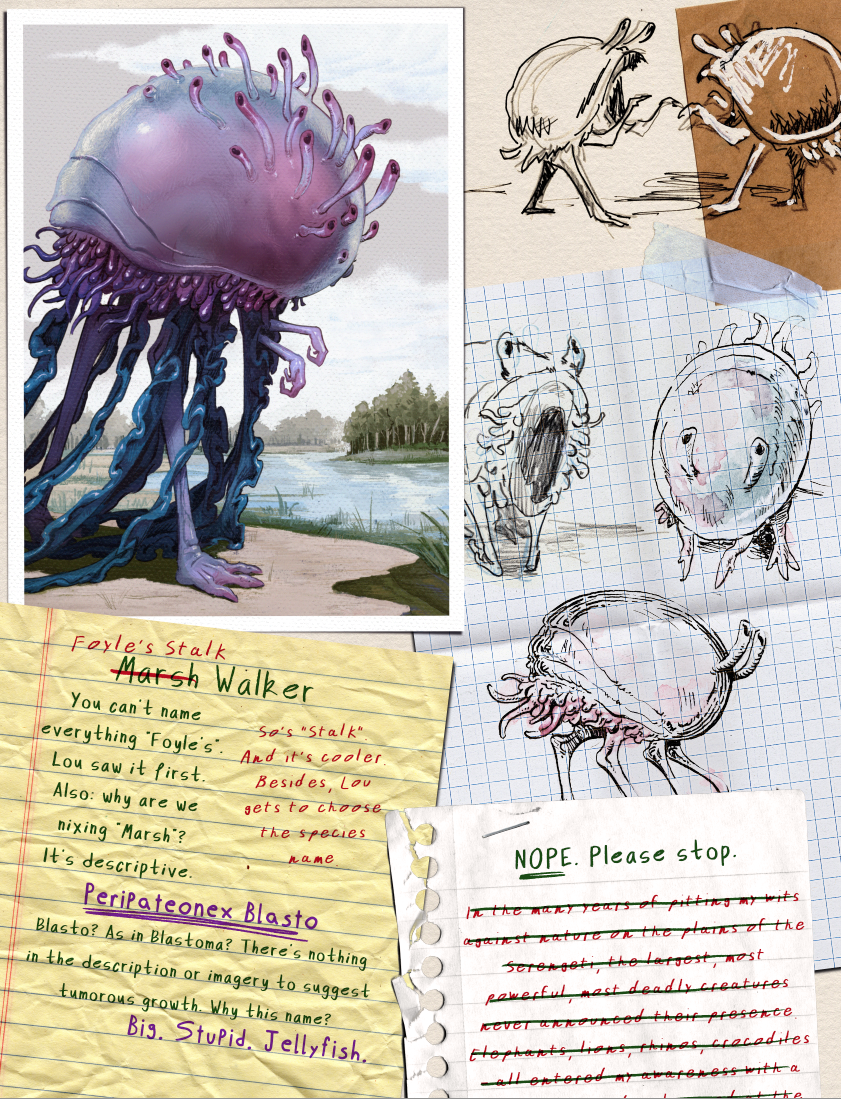
Yellow Note
JIN: You can’t name everything “Foyle’s”. Lou saw it first. Also: why are we nixing “Marsh”? It’s descriptive
BRANDON. So’s “Stalk”. And it’s cooler. Besides, Lou gets to choose the species name
Peripateonex Blasto
JIN: Blasto? As in Blastoma? There’s nothing in the description or imagery to suggest tumorous growth. Why this name?
LOU: Big. Stupid. Jellyfish.
White Note
???: In the many years of pitting my wits against nature on the plains of the Serengeti, the largest, most powerful, most deadly creatures never announced their presence. Elephants, lions, rhinos, crocodiles - all entered my awareness with a-???
JIN: NOPE. Please stop.
Page Two

Description
Dominating the marshes and streets of Palmyra, the 20ft-tall “Stalk” Walker defies easy classification. It displays many characteristics of an ocean-dwelling box jellyfish. The moist, translucent gelatinous flesh houses a number of internal organs faintly visible to the observer. The colours range from deep purples to lighter blue and pink hues that are discernible even in low light. Below the main body are a mass of wet, dark blue tendrils that dangle and drag on the ground beneath and behind. Atop the head are a mass of eye stalks, approximately two dozen in number, articulate but passive and unresponsive to their surroundings. To the front of the torso appears to be a small and pinched orifice, possibly a vestigial mouth, and suggestive of a creature that undergoes significant physiological and behavioral changes over the course of its lifespan.
Complicating its classification are two giant digitigrade legs, similar in structure to those of a wading bird, with a lengthy tarsometatarsus ending in a set of three digits. The structure of these very clearly indicate bone-and-sinew construction, and are at odds with the invertebrate nature of the creature’s torso. Furthermore, a set of two small arms are present to the front. Although never observed in use, these arms possess hands with multiple slender-clawed digits.
Environment
The “Stalk” Walker has only ever been observed within or in close proximity to the freshwater marshes on the outskirts of Palmyra. This environment suggests evolutionary reasons for the animal’s form, given that pools of any considerable depth are separated by large expanses of reedbeds and boggy terrain, providing a need for locomotion adapted to this terrain. How the more gelatinous parts of this creature’s physiology avoid becoming dehydrated during these traversals is currently unknown.
Behaviour
The “Stalk” Walker is a docile, placid creature. It displays a restrained response to external stimuli or is unable to sense all but the most extreme of inputs. It walks with surprising speed for a creature of its size and mass, with a steady and persistent gait and a natural stealth to its movements that could suggest some sort of ambush predator. However, the creature has not been observed to feed in any discernible way, and the presence of an atrophied mouth may suggest that the adult form may have moved onto alternative forms of nutrition, such as some form of photosynthesis, the filtering of small lifeforms from water, or by absorbing nutrients from the earth via its dragging tendrils.
Hazards
With any creature of this size, there is a danger inherent in interaction. Its oblivious nature and sheer mass means that the likelihood of injury to anyone who unknowingly gets in its way is always significant. However, this creature has never displayed any interest, malice, or predatory intent to any creature it encounters, so can be safely observed with care. When in proximity, it is advisable to avoid contact with the dragging tendrils as they excrete a mild venom, leading to feelings of numbness and mild irritation when in contact with exposed skin. However, these effects are minor and disappear within hours.
Page Three
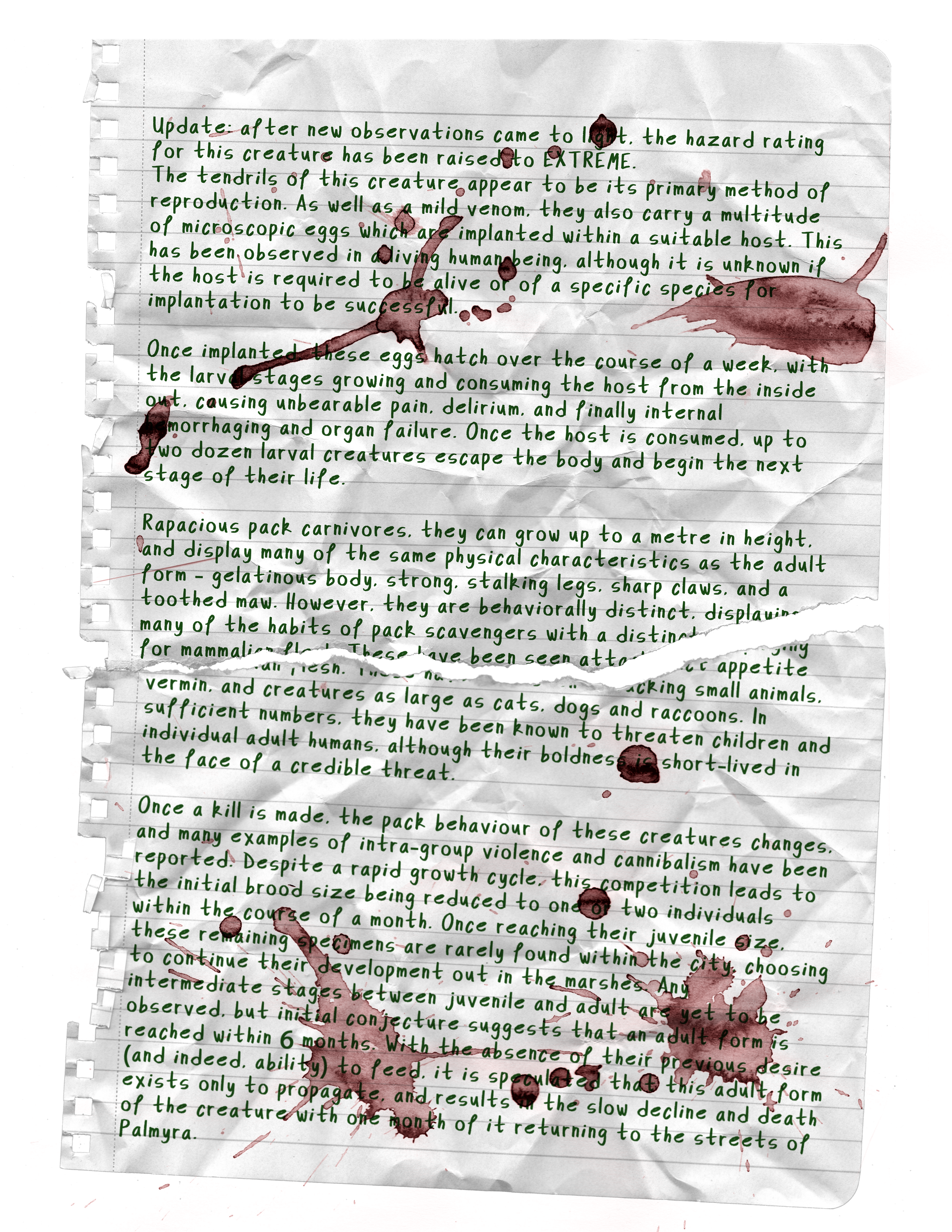
Update
Update: after new observations came to light, the hazard rating for this creature has been raised to EXTREME.
The tendrils of this creature appear to be its primary method of reproduction. As well as a mild venom, they also carry a multitude of microscopic eggs which are implanted within a suitable host. This has been observed in a living human being, although it is unknown if the host is required to be alive or of a specific species for implantation to be successful.
Once implanted, these eggs hatch over the course of a week, with the larval stages growing and consuming the host from the inside out, causing unbearable pain, delirium, and finally internal hemorrhaging and organ failure. Once the host is consumed, up to two dozen larval creatures escape the body and begin the next stage of their life.
Rapacious pack carnivores, they can grow up to a metre in height, and display many of the same physical characteristics as the adult form - gelatinous body, strong, stalking legs, sharp claws, and a toothed maw. However, they are behaviorally distinct, displaying many of the habits of pack scavengers with a distinct appetite for mammalian flesh. These have been seen attacking small animals, vermin, and creatures as large as cats, dogs and raccoons. In sufficient numbers, they have been known to threaten children and individual adult humans, although their boldness is short-lived in the face of a credible threat.
Once a kill is made, the pack behaviour of these creatures changes, and many examples of intra-group violence and cannibalism have been reported. Despite a rapid growth cycle, this competition leads to the initial brood size being reduced to one or two individuals within the course of a month. Once reaching their juvenile size, these remaining specimens are rarely found within the city, choosing to continue their development out in the marshes. Any intermediate stages between juvenile and adult are yet to be observed, but initial conjecture suggests that an adult form is reached within 6 months. With the absence of their previous desire (and indeed, ability) to feed, it is speculated that this adult form exists only to propagate, and results in the slow decline and death of the creature with one month of it returning to the streets of Palmyra.
Additional Images
